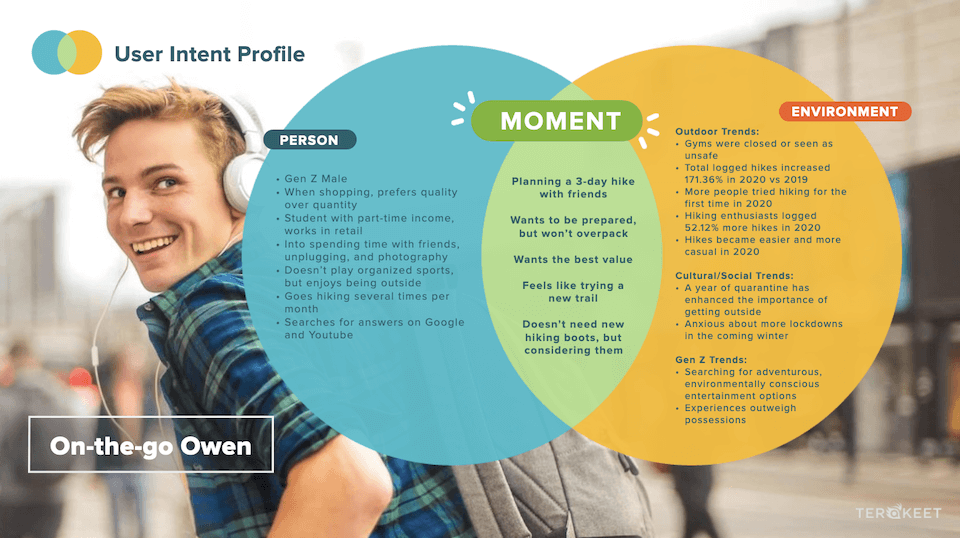
9 Examples of Buyer Personas for B2B & B2C Brands
Jun 12, 2020|Read time: 14 min.
Key Points
- A buyer persona is a semi-fictional representation of one of your target audiences.
- A persona helps you and your marketing team build strategies and messaging that are tailored to the persona’s values, goals, and pain points.
- Explore a range of buyer persona examples to help you build your own personas.
There are so many examples of buyer personas to choose from that it can be hard to know which template is right for your business. If you choose a format that includes irrelevant information, then your marketing team probably won’t use it.
As an inbound marketing manager, personas are a crucial tool to help you target your ideal customer base across the entire buyer’s journey. They help you understand, step-by-step, what potential customers are thinking at key decision-making moments so you can build a better digital marketing plan.
In this post, I‘ll showcase nine different buyer persona examples for B2B and B2C customers. You can also download our free template below to build your own.
Buyer Persona Template
Build better buyer personas to meet your consumers’ needs.
What to include in a buyer persona template
Buyer personas are fictional characters that represent specific segments of your target audience, so you should include any information to inform your marketing strategy
Brands comb through real-life customer data and market research to build each user persona. These avatars help you and your marketing team build strategies that are tailored to the persona’s values, goals, and pain points. They also help you visualize the real person you’re selling your products or services to so you can fine tune your marketing messages.
Buyer persona templates should include any information that may be useful to both marketing as well as your sales team. Ultimately, your template should help you understand decision-making behavior as well as common objections customers have to your brand. Your marketing personas may be very different from the personas of other companies. There’s no right or wrong way to put a persona together.
What’s important is that you gain value out of the insight derived from your personas so that you can connect with your audience more effectively. Ideally, your personas make your marketing efforts easier.
Most customer persona examples contain the following demographic information and personal attributes:
- Age
- Gender
- Location
- Marital status
- Family make-up
- Income level
- Education level
- Online sources of information
- Favorite shows (TV, Netflix, etc.)
- Social media accounts
- Goals
- Desires
- Passions or causes
- Frustrations or challenges
- Type of company (for B2B)
- Job title (for B2B)
- Who they report into (for B2B)
- First-person statements
The value of audience segmentation
Most brands have multiple target audience segments. For example, if you’re an apparel brand, you may be targeting not only teen girls, but also teen boys. Or, in addition to teen girls, your target customers may include tweens.
Within each audience segment, a brand may have one or multiple personas. For example, if a brand targets both teen girls and boys as audience segments, it may break down its personas within each of these segments according to specific age ranges within the teen years (e.g., 13-15, 17-19), or may define personas based on urban vs. rural teens, or based on attitudes, lifestyle, etc.
Use audience segmentation to scale your efforts
Audience segmentation is critical because it enables you to scale your targeting beyond individual personas. It may not be realistic to configure your website to target every persona individually.
In fact, that could hurt your SEO, resulting in reduced Google organic market share. Instead, target audience segments to reach each group of related personas cost-effectively. Remember, different personas could make similar purchasing decisions, so it would make sense to group them.
The secret is to scale by targeting audience segments overall. Then, create more specific messaging based upon psychographic, behavioral, intent, or demographic information. This unlocks your ability to run individual marketing campaigns that directly target your user personas where possible.
In other words, you’re going to segment your segments.
Content Strategy Playbook
The Fortune 500 CMO’s guide to content strategy.
Why you need customer personas in your content strategy
Buyer personas inform how you market to potential customers, including which social media platforms you leverage and how you craft your messaging.
Without clear examples of buyer personas, your business would be in the dark. For instance, you wouldn’t know what marketing campaigns to create, what product qualities and benefits will influence purchasing decisions, what pain points to address, or what emotions to evoke.
Over time, you’d lose audience interest and trust. And that’s a tough thing to earn back.
Even if your audience doesn’t leap to unsubscribe, your conversion rates will suffer when you market to everyone in a generalized way. Say you’re a retailer and your men’s suits are on sale. When that message gets lost in the general noise instead marketed to a specific persona directly, the people who’d be excited to buy suits miss the memo.
Personas help you share the right content with the right people at the right time. More importantly, they give you the insight you need to learn about your audience’s preferences, goals, challenges, and desires so that you can develop the best content strategy. With that, you can delight your audience with every single message.
Let’s dig into some examples of buyer personas that will inspire your own templates and help you extract better ROI from your B2B content marketing.
Examples of B2B buyer personas
B2B personas help you understand the fears, motivators, and mindset of key decision makers among your target customers. We’ve created some high-level examples of buyer personas to up your B2B lead generation game.
SaaS buyer persona examples

Let’s say that your business sells a content marketing automation and scheduling tool. Your set of audience personas could include the following:
Calvin, the In-House Content Marketer
- Millennial or Gen X
- Male or female
- Reports into Marketing Director
- Reads the Content Marketing Institute blog
- Pain points: It’s hard to manage the content production process; tasks slip through the cracks; manual spreadsheets aren’t robust enough.
When Calvin started at his company, they were small. They operated on a lean budget and he wrote 100% of the company’s blog posts. As the company grew, Calvin’s role did, too. He’s now in charge of coordinating content and outreach efforts across several channels, and he communicates with a small team of freelancers.
Calvin uses a spreadsheet to track posting schedules and assign topics to freelancers. But, keeping it up to date is a hassle. When freelancers are done with an assignment, they email it to Calvin directly and he schedules it into the blog. Communication and scheduling take up a great deal of Calvin’s time, which frustrates him. As a result, sometimes things slip through the cracks.
Calvin entered the field of content marketing because he’s creative. He’s not thrilled about the process part of his role, so he wants it to be as easy and automated as possible. He does care about his work, however, and wants his marketing strategy to produce results.
Sam, the Social Media Strategist
- Gen Z, Millennial, or Gen X
- Male or female
- Reports into Account Director
- Reads Social Media Today and Social Media Examiner
- Biggest frustration: Sam is spending too much time on coordination with other team members and on client reporting.
Sam works for a digital agency and manages social media for a portfolio of five or six clients at a time. Her plate is full, but she has her system nailed down to a science. She currently uses a scheduler to manage all her clients across platforms, but she’s looking for a new solution with better team collaboration and reporting features. The new solution must have all the same capabilities as the old one, plus more.
Because Sam works with clients, she wants reports that are clean, easy to digest and attractive. They should be client-ready when Sam runs the report – no wasting time reformatting the data or dropping it into a template. The solution would get serious bonus points from Sam if they could also generate insights about the data on the fly.
Consumer Connections Newsletter
Exclusive insights, trends, and actionable brand strategy, direct to your inbox.
Mary, the Digital Marketing Director
- Gen X or Boomer
- Male or female
- Reports into Marketing VP
- Reads the Wall Street Journal, CNN, NPR, and a mix of marketing blogs
- Biggest frustration: Mary needs her team to up their game when it comes to a structured, efficient, reliable process while achieving greater scale.
Mary manages an in-house digital marketing team with support from agency partners. She won’t be using the tool herself, but she pays attention to what her team members need and she’s been noticing they’re struggling with automation, coordination, scheduling, scalability, and reporting. Mary isn’t worried about budget, but practicality and scalability are top priorities.
To that end, she wants everyone on her team to use the same tools whenever possible. That means the solution must be flexible enough to meet a variety of needs, and user-friendly enough to quickly onboard everybody.
HR buyer persona examples

Let’s say that your business sells a simple, easy-to-use employee feedback system. Your buyer personas might include:
Diane, the VP of HR
- Gen X or Boomer
- Male or female
- Reports into the CEO
- Reads the HR Bartender and HPPY blogs
- Biggest frustration: Employees don’t voice their concerns to HR. As a result, they have a mountain of negative Glassdoor reviews.
Diane’s company spends millions of dollars per year on employee happiness: top-notch benefits, bottomless cold brew, events, workshops, and tons of office perks. Yet, every time she visits Glassdoor, she greets a sea of unhappy reviews. The company’s strategy, CEO, and the day-to-day grind all come under fire affecting brand reputation.
Diane has tried to build a culture of openness so that people feel comfortable coming to HR with their problems and feedback before they hit Glassdoor, but nobody does. She needs a system that will help her team gather quick feedback frequently and aggregate the data into a set of logical takeaways. In other words, Diane needs a more agile way to keep her finger on the pulse of how employees are actually feeling. While Diane believes anonymity is paramount to honest feedback, she does need a general sense of where the feedback is coming from so she can pinpoint whether specific teams are less happy than others.
Diane wants HR to survey each employee every two weeks. She’d also like employees to be able to easily provide anonymous feedback, from their phones, in under two minutes. Diane has certain KPIs to hit. However, she genuinely wants her company’s employees to love where they work.
Fortune 500 Enterprise SEO Playbook
Discover how enterprise brands can create content that builds authentic audience connections.
Evan, the Entry-Level Employee
- Gen Z or Millennial
- Male or female
- Reports into a Manager
- Information sources are varied across the employee base
- Biggest frustration: Evan is overwhelmed by the internal politics that seem to drive the behavior of managers. He feels there’s no realistic way for him to voice his views or concerns without retaliation.
Evan has been working at his company for two years. He’s comfortable there, but he knows things could be better and the mismanagement he sees at the top frustrates him. The internal politics are overwhelming. He believes he and his fellow employees have valuable insights that go unheard, and going around an immediate manager to voice one’s dissenting view would be a recipe for a horrendous performance review.
If the company had an anonymous feedback system in place, especially something he could use easily and frequently, Evan would gladly use it. However, he needs to fully trust that the feedback really is anonymous. If the HR software’s messaging implies that it’s on the side of the company and not the employees, Evan won’t use it.
B2C Examples of buyer personas
Below, I’ll walk through some B2C buyer persona examples to help you connect and engage with your audience more effectively.
Ecommerce buyer persona examples

If your business sells hiking equipment and outdoor apparel then you might create a persona like this one. (By the way, you can download the above persona template at the top of this blog post)
On-the-go-Evan
- Gen Z
- Male
- Information sources include hiking blogs, outdoor catalogues, social media
- Biggest frustration: Buying equipment that doesn’t last, or doesn’t meet his needs. Owen is comfortable paying a little extra to get higher quality gear for his hikes.
Owen loves being outside, but he doesn’t really like competing in sports. He prefers to experience nature at his own pace.
Although he has a limited budget, Owen doesn’t hesitate to buy premium hiking gear that will last. He relies on reviews, influencers and blog posts for unbiased information about the best equipment for the types of trails he prefers.
Owen has a few favorite brands, but he’s always open to new ideas as long as they’re recommended by a trusted source. Currently, Owen is looking for a new pair of hiking boots to replace his previous pair. They held up well, but he didn’t love them enough to buy another pair. He’s also more experienced now, and he wants the best he can afford.
Or, if your brand sells women’s activewear, this persona may be up your alley.
Caitlynn, the Comfort Queen
- Gen Z, Millennial, or Gen X
- Female
- Information sources include Self, Women’s Health, and Disney Family
- Biggest frustration: Caitlynn doesn’t want to compromise between activewear that’s fashionable or functional; she wants her outfits to be both.
Caitlynn works mornings from home, and in the afternoon she’s constantly on the go. From grocery shopping to walking her seven-year-old home from the bus stop, Caitlynn gets her 10,000 steps a day in – she just doesn’t do it at the gym.
Caitlynn used to squeeze into heels for her office job every day, but now she lives in tennis shoes, yoga pants and other comfortable attire. Her life is full and busy, and there’s simply no reason to suffer for fashion.
That said, Caitlynn isn’t going to leave the house looking like a slob. She’s appearance- and brand-conscious, and her ideal clothing is an even blend of form and function. She favors flattering options that help her feel at home in any setting, not clothing that makes her look like she came straight from the gym without changing.
Auto insurance buyer persona examples

Anne, the Average Driver
- Millennial
- Female
- Information sources include Consumer Reports and NerdWallet
- Biggest frustration: Caitlynn is sick and tired of cute marketing but “Gotcha” clauses in the small print. She knows she’s a good driver, and simply wants a brand she can trust.
Anne drives her car an average amount: to and from work, and occasionally across town to visit friends or pick up groceries. Aside from one minor fender-bender when she was 20 and a couple of speeding tickets, Anne has had a clean driving record throughout 15 years of driving.
Like most people, Anne isn’t passionate about car insurance shopping. She just wants a low rate from a company that won’t give her the runaround when she needs them. While price is important, trust in the brand is the trump card; low rates or not, she wouldn’t buy insurance from a brand she’s never heard of. When she’s in the market for new insurance, she asks friends and coworkers about their rates and reads reviews.
Transparency is also crucial for Anne. If you surprise her with hidden fees or neglect to mention the fine print in your sales pitch, you’ve lost a customer for life.
Tim, the Teenager’s Dad (AKA Tim, the Terrified)
- Gen X or Boomer
- Male
- Information sources vary widely, including CNN and USA Today
- Biggest frustration: Tim is a caring father and is stressed out about his teenage son’s safety (and potentially skyrocketing car insurance costs in the case his son gets in an accident).
Tim’s 17-year-old son has had his driver’s license for a year, and he uses the family’s second car as his own. He’s a great kid, but he’s prone to distraction and Tim knows his son shuttles his friends around. Worries about his son’s safety keep Tim up at night, but that’s not all – he also shudders to think about his insurance premiums in the event of an accident. On top of that, he worries that Tim may inadvertently injure his friends if they’re in the car with him at the time of an accident.
Tim is looking for an insurance company that’s comprehensive, reliable, and sympathetic. He’d also like them to appreciate his son’s good initial driving record. Furthermore, he wants them to provide guidance on how to keep his son as safe as possible.
Value of Organic Search White Paper
See how an investment in organic search delivers ROI that compounds over time.
Take your buyer personas to the next level
After you use the above buyer persona ideas to generate your own examples, think about how those individuals engage with your brand throughout their journey. When and where do they first encounter you? What are their preconceptions? How many customer touch points exist between their need and your solution?
Read our article about how to create buyer personas to make sure you don’t leave out anything crucial. Then, check out our post about customer journey mapping to visualize all the brand interactions and touch points you need to influence.
These are just the first steps in creating an unbelievable digital customer experience that wins traffic and expands your audience.




